Wine is an alcoholic beverage most often made from the juice of grapes. Wine also can be made from a variety of other fruits, including apples and pears, and even from such plants as dandelions. For thousands of years, people have used wine to complement meals and for celebration. They have also used it in cooking and medicine and in religious ceremonies.
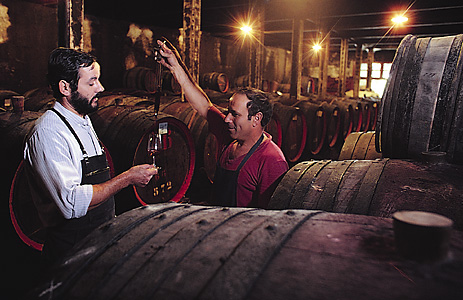
Types of wine.
Grape wines can be divided into four categories. They are (1) table wines, (2) sparkling wines, (3) fortified wines, and (4) flavored wines.
Table wines
are the most commonly produced type of wine. They are typically served with meals. They may be grouped by color into red, white, and rosé (pink) wines. Crushed grapes produce a light green or yellow juice. During fermentation, the process by which juice turns to wine, the juice absorbs color from the grape skins. In general, red and rosé wines are made from red or purple grapes, and white wines from white grapes. But a type of white wine called blanc de noir is made from red grapes. The grape skins have little contact with the juice, giving blanc de noir a paler color than rosé.
Wine drinkers describe a wine that lacks sweetness as dry. Most red table wines are dry. But white and rosé wines range from dry to sweet. Some white wines can be quite sweet. Table wines typically have from 7 to 14 percent alcohol by volume.
Sparkling wines,
such as the champagnes, contain bubbles of carbon dioxide gas typically produced during a secondary fermentation involving yeast. People enjoy drinking sparkling wines on festive occasions.
Fortified wines,
such as port and sherry, have brandy or wine alcohol added to them. Most have from 18 to 24 percent alcohol. Fortified wines tend to be sweeter than most other wines. For this reason, some people prefer to drink them with dessert or after a meal, and so these wines are often called dessert wines. Other people choose to drink dry sherry or white port before dinner.
Flavored wines
contain flavoring substances. For example, vermouth is a white wine flavored with herbs. Wine coolers are wines flavored with fruit juices. Most flavored wines are served alone or before a meal.
Where wine comes from.
Most of the world’s wine comes from grapes belonging to the species Vitis vinifera, which originated in the Middle East. Vinifera grapes are also known as European grapes. These grapes thrive in the vineyards of Europe and on the West Coast of the United States, as well as in Australia, New Zealand, and South America. In the eastern United States and in Canada, vinifera grapes have been crossbred with species native to North America, chiefly Vitis labrusca and Vitis riparia. These hybrid grapes can withstand cold climates better than European grapes can.
Grape species are made up of many varieties, called cultivars. In the United States, many wines take the name of the variety of grapes from which they are principally made. Such wines are often called varietals. They include Cabernet Sauvignon, Chardonnay, and Pinot Noir. According to U.S. law, a varietal wine must contain at least 75 percent of the variety after which it is named.
Most European wines are classified by the region from which they come, such as Burgundy or Bordeaux in France or the valley of the Rhine River in Germany. Wines called generics sometimes take the name of a region in Europe, even though they may show little resemblance to wines from that region. A generic wine is usually a blend of several varieties of grapes.

Most nations produce some wine. Well-known wine-producing countries include Argentina, Australia, China, France, Italy, Germany, Portugal, South Africa, Spain, and the United States.
Wines from France
are well-known, in part due to the country’s growing conditions and its long tradition of winemaking. France’s chief winemaking regions include Bordeaux, in southwestern France; Burgundy, in east-central France; and Champagne, east of Paris.
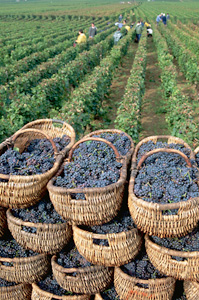
In the Bordeaux region, Cabernet Sauvignon, Merlot, and other grapes are used to make dry red wines. White Bordeaux wines come from Semillon and Sauvignon Blanc grapes. Pinot Noir grapes form the basis of the red wines of Burgundy. White Burgundy wines come from Chardonnay grapes. Chardonnay and Pinot Noir grapes are also the primary varieties used in making the sparkling wines of the Champagne region.
Wines from Italy.
The red wines of the Piedmont region in northwestern Italy are known as Barolo and Barbaresco. They come from Nebbiolo grapes. Chianti, probably the most familiar Italian wine, comes mainly from Sangiovese grapes native to the regions of Tuscany and Umbria in central Italy.
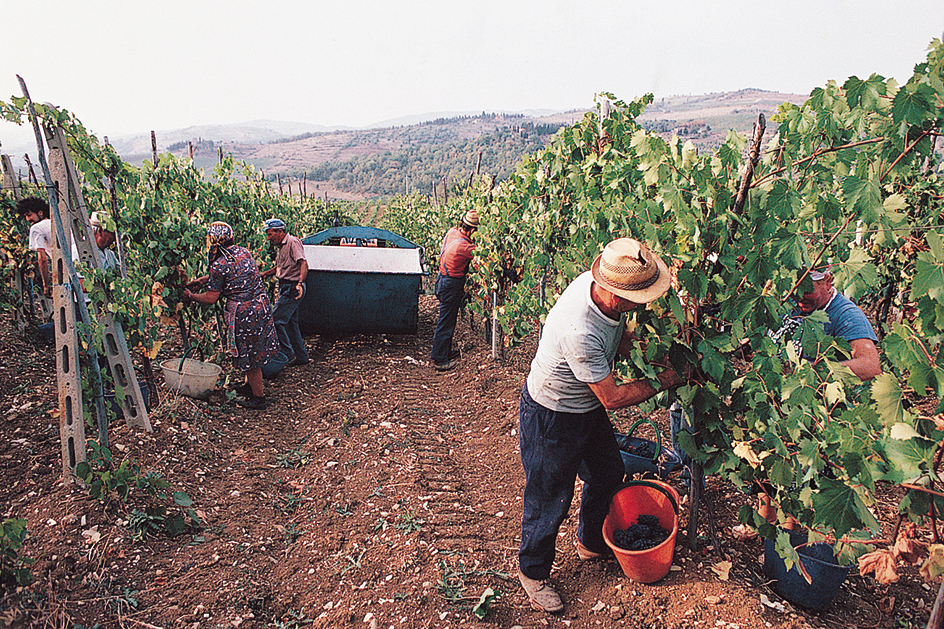
Wines from Germany.
Germany’s distinctive white wines are produced mainly from Riesling grapes. Riesling wines come from all of the country’s winemaking regions, particularly those along the Rhine, Moselle (or Mosel), and Nahe rivers.
Wines from the United States.
California is by far the leading state in wine production. The state’s most widely recognized wine regions include Napa and Sonoma counties. California’s major inland valleys, as well as the foothills and the coastal areas, produce fine wines. Oregon and Washington, and several Midwestern and Eastern states, also produce wines.
Wine styles from other countries
include port and sherry. Port may be dark red or white. It was first made from grapes grown in the Douro Valley in northern Portugal. Sherry ranges from pale gold to brown and from dry to sweet. Sherries are made from grapes grown in Jerez in southwestern Spain. Argentina’s main winemaking regions are the provinces of La Rioja, Mendoza, Salta, and San Juan. Australia’s main wine-producing areas are near the southeast and southwest coasts of the country. Leading wine-producing areas in China include Hebei, Henan, Liaoning, and Shandong provinces and the Xinjiang autonomous region. Western Cape is South Africa’s chief winemaking region.
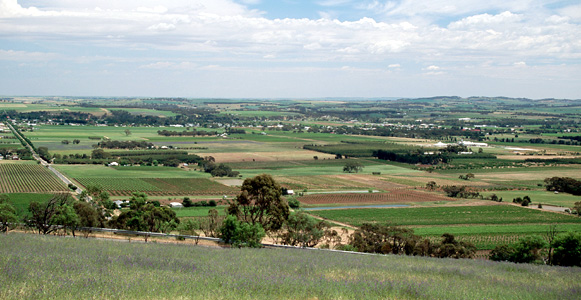
How wine is made.
Winemaking requires a series of steps. Decisions made by the winemaker during each step influence the final “character” of the wine. A winemaker must first decide which grapes to use and when to harvest them. After the grapes are crushed, the juice is converted into wine through fermentation. Wine is then aged until it is ready for drinking.
Harvesting the grapes.
Grape growers harvest their crop as soon as the grapes have ripened, usually in the fall. Winemakers commonly measure ripeness by full flavor and aroma development, which occurs along with the development of sugar in the grapes. Workers pick grapes by hand or with mechanical harvesters that shake the fruit from the vine. The grapes then go to the winery for processing. The grape harvest is sometimes called the vintage. In some years, a favorable climate produces grapes of especially high quality.
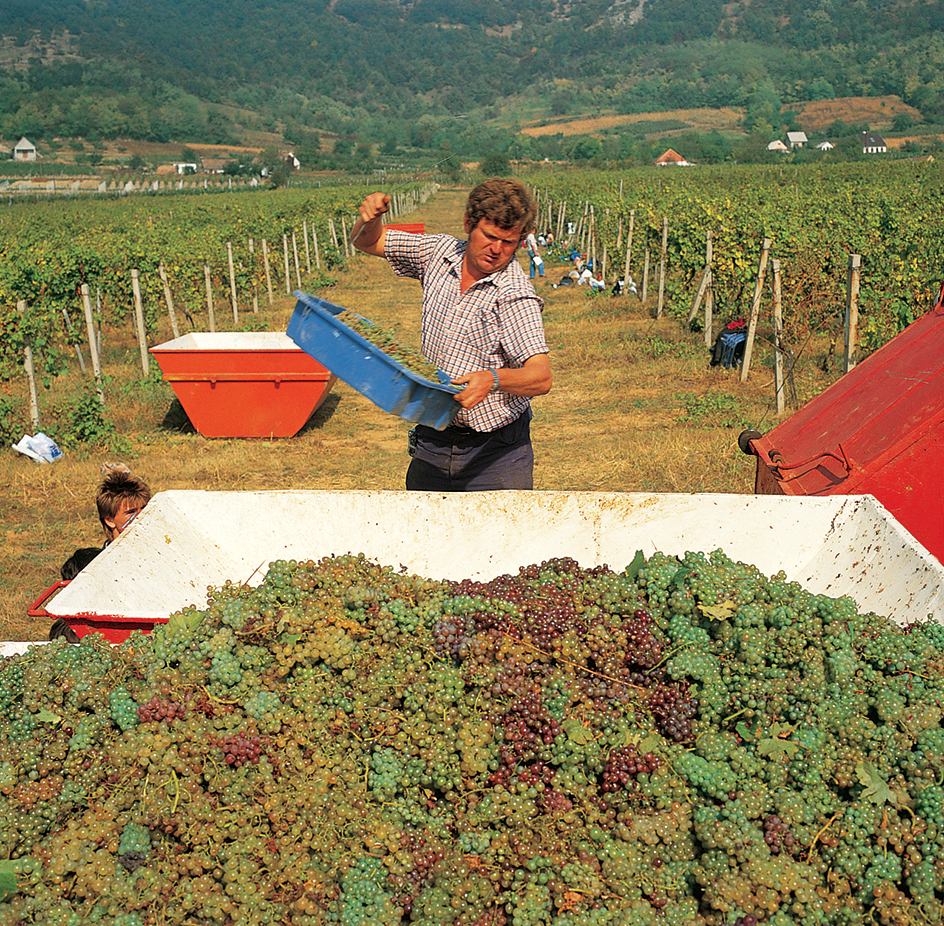
Preparing the juice.
At the winery, a machine called a crusher breaks the grapes and removes them from their stems. The crushed grapes and their juice are called must. The length of contact between the juice and the skin affects the color of red wines and the taste of all wines. To make white wine, winemakers separate the skins and pulp from the juice. The juice then enters a tank or barrel for fermentation. In making red wine, the seeds and skins go into the fermentation tank with the juice. Regular stirring of the mixture ensures that the color is extracted from the skins.
Fermentation
is a series of naturally occurring chemical changes in which yeast converts grape sugar into alcohol. Some yeast grows on the skins of grapes, and some winemakers allow this “native” yeast to conduct the fermentation. In the United States and most other countries, winemakers add selected yeasts to the must to begin fermentation. During fermentation, the yeast grows and converts the grape sugars into alcohol and carbon dioxide gas. The carbon dioxide is released as bubbles. The yeast also produces various by-products that may, directly or in combination with the grape, add to the wine’s flavor, aroma, and complexity (balance of flavor and taste components).
Fermentation also releases heat. Most wineries refrigerate the must to keep its temperature constant during fermentation. Winemakers usually ferment juice for white wine at less than 60 °F (16 °C) and for red wine at less than 85 °F (29 °C). The temperature of the must influences not only the rate of fermentation but also the retention of grape aromas and the formation of yeast by-products. It also determines the rate at which the color and flavor of the grape skins transfer into the wine. The fermentation of red wine takes from 4 to 6 days. White-wine fermentations last from 12 to 18 days.
Winemakers add bacteria to most red table wines and some white table wines to produce a secondary fermentation called malolactic fermentation. This process lowers the wine’s acid content by converting a substance called malic acid into lactic acid. It also modifies the wine’s flavor and bouquet (aroma).
Clarifying and aging the wine.
A new wine appears cloudy after fermentation. Winemakers clarify the wine by removing tiny particles of yeast and other matter. These substances may be filtered out, allowed to settle naturally, or separated from the wine by a machine called a centrifuge. Winemakers further clarify, or fine, the wine by adding certain solutions that reduce the content of unstable or unpleasant components.

After clarification, wine goes into wooden barrels or stainless steel tanks for aging. Wooden barrels contribute their own flavor to the wine. The size of the barrel, the age of the wood, the storage temperature and humidity, and the length of storage time all influence the extent of the aging process. Many wineries hold wine at a temperature close to freezing for one or more days so that potassium bitartrate, a crystalline salt, will precipitate (separate) out of the wine. This action prevents precipitation of the salt after the wine is bottled.
Some wines are soon ready for drinking. Others need aging to soften harsh flavors and allow desirable flavors to develop.
Fortified wines are made by adding brandy to fermenting must. The alcohol stops the fermentation by killing the yeast before all the sugar has been converted to alcohol. The wine that results generally is sweet. Drier fortified wines are achieved by adding brandy near or at the end of fermentation.
Sparkling wines are usually produced by a secondary yeast fermentation of a blend of table wines. This fermentation may take four to eight weeks. It produces carbon dioxide gas that remains trapped in the wine and which creates a bubbling effect once the wine is opened.
History.
The earliest references to wine date back about 8,000 years to villages in ancient Georgia in the Caucasus Mountains at the eastern end of the Black Sea. Chemical traces of wine were found in pottery jars which displayed images of grape clusters and a man dancing. Egyptian picture writing 5,000 years ago shows people harvesting and crushing grapes and storing wine in clay vessels. The Bible tells of winemaking in Canaan (later called Palestine). The ancient Greeks and Romans dealt extensively with wine in their paintings and writings. The Romans planted grapevines in regions they conquered, including what are now Austria, France, and Germany.
From about A.D. 500 to 1400, the spread of Christianity in Europe encouraged grape growing to make the wines used in religious ceremonies. After the 1500’s, European explorers and settlers introduced vinifera grapes to the lands now known as Argentina, Australia, Brazil, Chile, Mexico, New Zealand, South Africa, and the United States.
